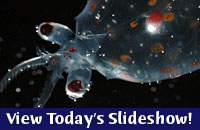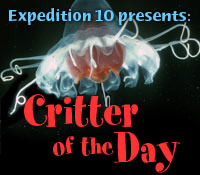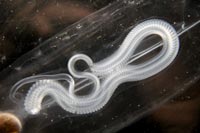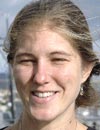|
  Today's Weather Cloudy Latitude: 63 54.2 S Longitude: 66 45.0 W Wind: 13 KT Sea State: 3 Swell Height: 2-3 Baro Pressure: 978 mB Air Temp: 5.7°C Sea Surface Temperature: 3.3°C Vis: 10 NM
March 2, 2006 by Kate Madin The routine of our cruise was different today. We all waited anxiously for this evening, when we brought in the net from far deeper than we’ve yet seen on this cruise, more than 1 mile (1.6 kilometers) down. Today, we took a step back to an earlier age of oceanography. At three this afternoon, its mouth gaping, our largest net slid off the stern of the Gould to tow at 6,000 feet (1,800 meters). We were using the massive 10-meter MOCNESS, to explore the deep sea the same way early oceanographic pioneers might have done—with a net. “The ocean here is really not known very well,” said chief scientist Larry Madin, who decided to make this tow. “Very few people have ever fished a net as deep as this in Antarctic waters. We could find something we’ve never seen.” The net carries sensors to collect information about the water it passes through and is controlled through electrical signals sent down the winch wire by a human pilot at a computer. As it sank, more than 13,000 feet (+4,000 meters) of wire spun off the winch. Its five collecting nets sampled from different depth layers, and the tow lasted four hours. “I want to see the deep animals,” Erich said. “There could be deep-living squid, black fishes, or huge jellyfish at that depth.” Four hours later, the tow was complete, the net back up. It took nine people to fight with heavy netting and secure the net to the frame. Cold and wet, the team came inside with the samples. Wally ended up under masses of rapidly dripping net, trying to fasten it correctly. “I didn’t expect a shower!” she said. And then, of course, we examined the catch. The surprise was that salps were living deeper than anyone thought. And there were lots of them there. It now seems that salps dominate this whole part of the ocean. Other creatures in the net included an unusual black fish and a very tiny squid with red spots. “There are really interesting animals down there,” said Brenna. “The important thing,” said Pat, “is that there are so many salps where we didn’t expect to see them.” “Another thing,” said Wally, “was the anticipation—people were talking about this all day.”
Read the new interview
|
|||||||||||||||||||||||||||||||||||||||||||||||||||||||||||||||||||||||||||||||||||||||||||||
Mailing List | Feedback | Glossary | For Teachers | About Us | Contact
© 2010 Dive and Discover™. Dive and Discover™ is a registered trademark of Woods
Hole Oceanographic Institution




